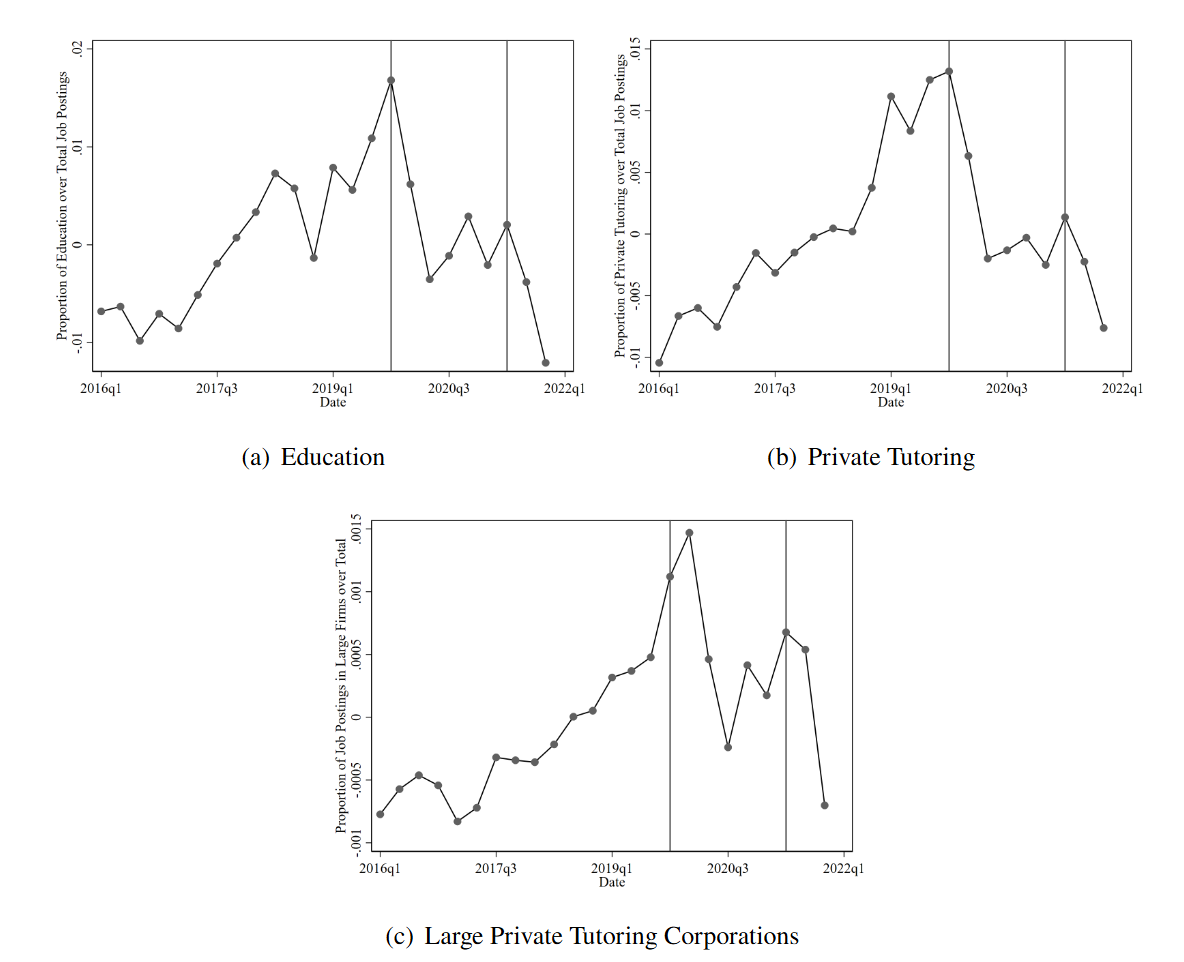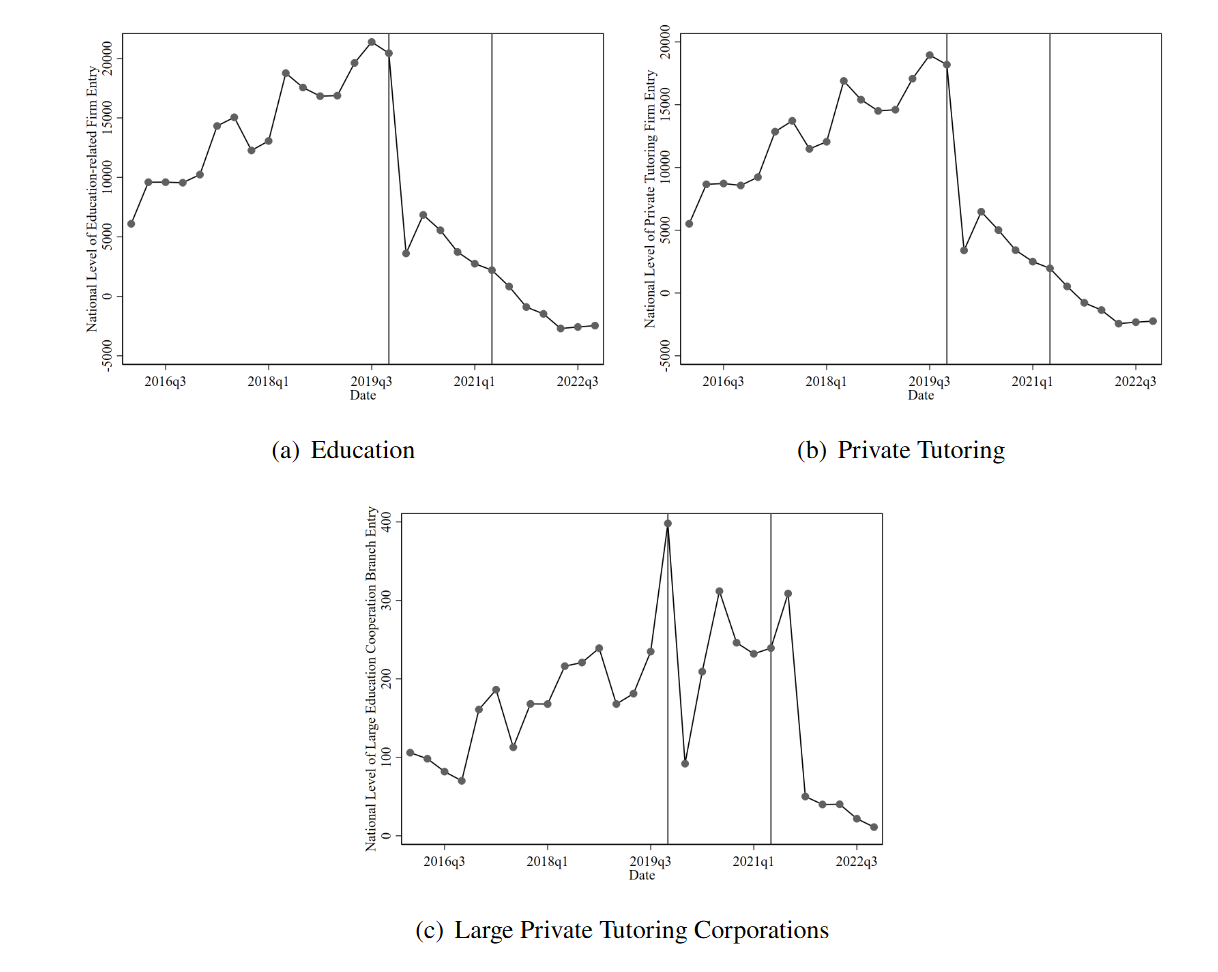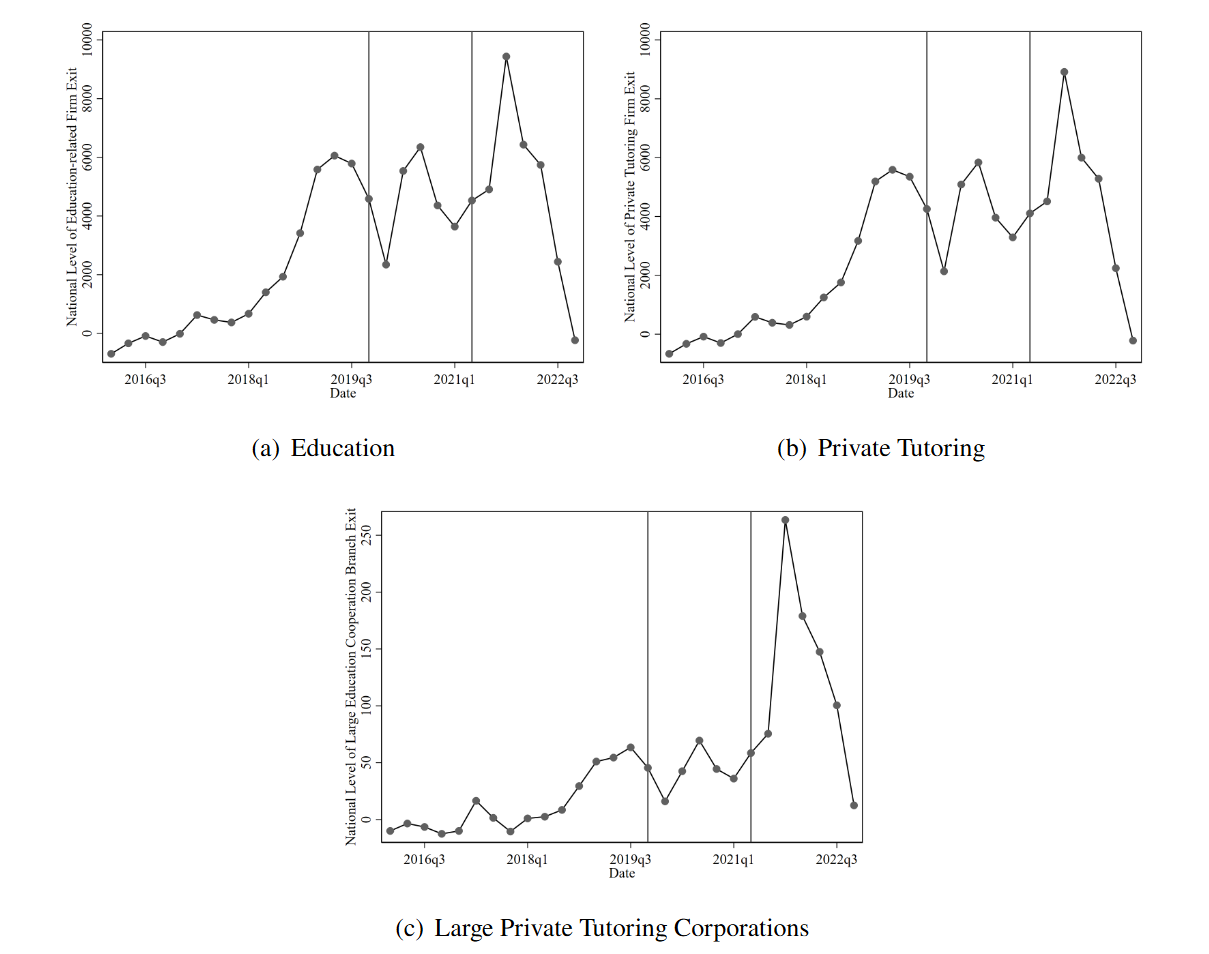The Economic Toll of China’s Tutoring Ban
China's 2021 “Double Reduction'' policy, which banned for-profit K12 academic tutoring, triggered an abrupt contraction in the education-services labor market. Using real-time job-posting and firm-registration data, we estimate over three million job openings lost in four months and at least 11 billion RMB in value-added tax (VAT) revenue losses within 18 months, alongside unintended negative spillovers to untargeted arts and sports training.

Policy Background
Private supplementary tutoring (shadow education) has grown worldwide, promising achievement gains but also raising concerns about inequality and misallocation (Dawson, 2010; Kim and Lee, 2010; Guo, 2022). China’s policy community has debated these trade-offs intensely. In July 2021, the central government launched the Double Reduction policy (DR policy), banning for-profit K12 academic tutoring nationwide and requiring existing operators to convert to non-profits or exit. The reform aimed to ease student burdens and reduce education inequality. What were the short-run economic consequences?
Data and Identification
We combine two complementary national datasets: (i) high-frequency online job postings tracking labor demand, and (ii) monthly firm registration records documenting entries and exits. Our empirical strategy is a difference-in-differences (DID) design that exploits cross-city variation in exposure to the DR policy, proxied by the population size of school-age children. All cities faced the ban, but locations with more children had larger pre-policy tutoring markets and thus more intense policy exposure.
General Findings
(1) Labor demand collapsed immediately. Education-related postings plunged after July 2021. Figure 1 shows the national time series for job postings proportions (relative to total job postings of all firms) of all education-related firms (sub-figure a), academic private tutoring firms (sub-figure b), and large tutoring cooperations (sub-figure c). We find a sharp break following the policy announcement. In city-level DID estimates, more-exposed cities experienced significantly larger declines in education-related job vacancies. Cities with 10,000 (2%) more children lost 50 (2.2%) more education-related job opportunities per month.
(2) Firm dynamics mirrored the hiring freeze. Similarly, we find that new registrations of tutoring firms fell steeply (Figure 2) while exits surged (Figure 3); net entry turned sharply negative. The contraction was strongest where pre-policy exposure was highest. Cities with 10,000 (2%) more children experienced 0.4 (2.8%) fewer firm entries, and 0.03 (0.8%) more firm exits per month.
(3) Unintended spillovers to untargeted segments. Despite policy encouragement for non-academic tutoring, arts and sports training providers also contracted, roughly doubling the sector-wide impact relative to effects measured on academic tutoring alone. Ownership linkages where entrepreneurs co-owned academic and non-academic operations, help explain these spillovers.
(4) Macro magnitudes and persistence. Back-of-the-envelope calculation implies 3+ million job openings lost in four months and at least 11 billion RMB in VAT losses over 18 months. Dynamic estimates indicate that postings and firm entries remained depressed through 2022, suggesting a persistent rather than transitory shock.
Conclusion
In this study, we investigated the economic consequences of the DR Policy in China, which aimed at a total ban on for-profit academic private tutoring. In general, the DR Policy caused a sharp plummet in the number of firms operating in the academic private tutoring and education sector, leading to significant losses in job opportunities and tax revenue in the short run. China’s experience offers rare, real-time evidence on the economic consequences of contractionary industrial policy—the deliberate dismantling of a large sector. Whether the reform ultimately alleviates student pressure and narrows inequality is a vital question for future work. Our findings caution that even well-intentioned policies can have unintended consequences for the workforce they affect, underscoring the need for credible transition support to accompany such reforms.
Figure 1. Changes of Job Postings in Proportions (2016 Q1 to 2021 Q4)

Notes: The x-axis represents the date from 2016 Q1 to 2021 Q4. We remove the seasonality by first regressing the original data on the quarter fixed effect and then take the residual to draw these figures. Subfigure (a) shows the proportion of the number of postings for all education and training firms over all job postings. Subfigure (b) shows the proportion of the number of postings for academic private tutoring firms directly impacted by the Double Reduction Policy over all job postings. Subfigure (c) shows the proportion of the number of postings for large private tutoring corporations over all job postings. The first vertical line locates in Q4 2019, when the COVID-19 pandemic started. The second vertical line locates in Q2 2021, just before the Double Reduction Policy was implemented.
Sources: Online Job Posting Dataset
Figure 2. Changes of Firm Entries (2016 Q1 to 2022 Q4)

Notes: The x-axis represents the date from 2016 Q1 to 2022 Q4. We remove the seasonality by first regressing the original data on the quarter fixed effect and then take the residual to draw these figures. Subfigure (a) shows the number of newly-registered education and training firms. Subfigure (b) shows the number of newly-registered academic private tutoring firms directly impacted by the Double Reduction Policy. Subfigure (c) shows the number of newly-registered large private tutoring corporation branches. The first vertical line locates in 2019 Q4, when the COVID-19 pandemic started. The second vertical line locates in 2021 Q2, when the Double Reduction Policy was implemented.
Sources: Firm Registration Dataset
Figure 3. Changes of Firm Exits (2016 Q1 to 2022 Q4)

Notes: The x-axis represents the date from 2016 Q1 to 2022 Q4. We remove the seasonality by first regressing the original data on the quarter fixed effect and then take the residual to draw these figures. Subfigure (a) shows the number of deregistrations for all education and training firms. Subfigure (b) shows the number of deregistrations for academic private tutoring firms directly impacted by the Double Reduction Policy. Subfigure (c) shows the number of deregistrations for large private tutoring corporation branches. The first vertical line locates in 2019 Q4, when the COVID-19 pandemic started. The second vertical line locates in 2021 Q2, when the Double Reduction Policy was implemented.
Sources: Firm Registration Dataset
(Zibin Huang, Shanghai University of Finance and Economics; Yinan Liu, Renmin University of China; Mingming Ma, Xi'an Jiaotong-Liverpool University; Leo Yang Yang, Hong Kong Baptist University)
References
Dawson, Walter. 2010. “Private Tutoring and Mass Schooling in East Asia: Reflections of Inequality in Japan, South Korea, and Cambodia.” Asia Pacific Education Review 11:14–24.
Kim, Sunwoong and Ju-Ho Lee. 2010. “Private Tutoring and Demand for Education in South Korea.” Economic Development and Cultural Change 58 (2):259–296.
Guo, Juncong and Xi Qu. 2022. “Competition in Household Human Capital Investments: Strength, Motivations and Consequences.” Journal of Development Economics 158:102937.
Zibin Huang, Yinan Liu, Mingming Ma, Leo Yang Yang. 2025. “Biting the hand that teaches: Unraveling the economic impact of banning private tutoring in China”, Journal of Comparative Economics, ISSN 0147-5967, https://doi.org/10.1016/j.jce.2025.07.002.

Latest
Most Popular
- VoxChina Covid-19 Forum (Second Edition): China’s Post-Lockdown Economic Recovery VoxChina, Apr 18, 2020
- China’s Great Housing Boom Kaiji Chen, Yi Wen, Oct 11, 2017
- China’s Joint Venture Policy and the International Transfer of Technology Kun Jiang, Wolfgang Keller, Larry D. Qiu, William Ridley, Feb 06, 2019
- Wealth Redistribution in the Chinese Stock Market: the Role of Bubbles and Crashes Li An, Jiangze Bian, Dong Lou, Donghui Shi, Jul 01, 2020
- The Dark Side of the Chinese Fiscal Stimulus: Evidence from Local Government Debt Yi Huang, Marco Pagano, Ugo Panizza, Jun 28, 2017
- What Is Special about China’s Housing Boom? Edward L. Glaeser, Wei Huang, Yueran Ma, Andrei Shleifer, Jun 20, 2017
- Privatization and Productivity in China Yuyu Chen, Mitsuru Igami, Masayuki Sawada, Mo Xiao, Jan 31, 2018
- Evaluating Risk across Chinese Housing Markets Yongheng Deng, Joseph Gyourko, Jing Wu, Aug 02, 2017
- How did China Move Up the Global Value Chains? Hiau Looi Kee, Heiwai Tang, Aug 30, 2017
- China’s Shadow Banking Sector: Wealth Management Products and Issuing Banks Viral V. Acharya, Jun Qian, Zhishu Yang, Aug 09, 2017




 Facebook
Facebook  Twitter
Twitter  Instagram
Instagram WeChat
WeChat  Email
Email 


